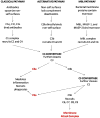Complement in neuroprotection and neurodegeneration
- PMID: 20116331
- PMCID: PMC2824068
- DOI: 10.1016/j.molmed.2009.12.001
Complement in neuroprotection and neurodegeneration
Abstract
Acute neurodegeneration is associated with high morbidity and mortality, and there are few effective treatments. Inflammation is central to the process of neuronal death, yet the roles of the complement cascade in this process have proven to be complex and hard to unravel. The complement cascade is involved in triggering cell death and recruiting cells of the immune system to sites of inflammation, including the brain. However, complement might also have important neuroprotective roles that are only now coming to light. Recent evidence suggests that targeted activation of complement might be a potential approach for treatment of stroke and other acute neurodegenerative diseases. Here, we review these novel neuroprotective roles of the complement cascade, focusing on signaling pathways that might provide new therapeutic targets in acute neuronal injury.
Figures


References
-
- Kanduc D, et al. Cell death: apoptosis versus necrosis (review) International journal of oncology. 2002;21:165–170. - PubMed
-
- Jacobson MD, et al. Programmed cell death in animal development. Cell. 1997;88:347–354. - PubMed
-
- Raff MC. Social controls on cell survival and cell death. Nature. 1992;356:397–400. - PubMed
-
- Cohen JJ. Apoptosis. Immunology today. 1993;14:126–130. - PubMed
-
- Friedlander RM. Apoptosis and caspases in neurodegenerative diseases. The New England journal of medicine. 2003;348:1365–1375. - PubMed
Publication types
MeSH terms
Substances
Grants and funding
LinkOut - more resources
Full Text Sources
Other Literature Sources
Medical

